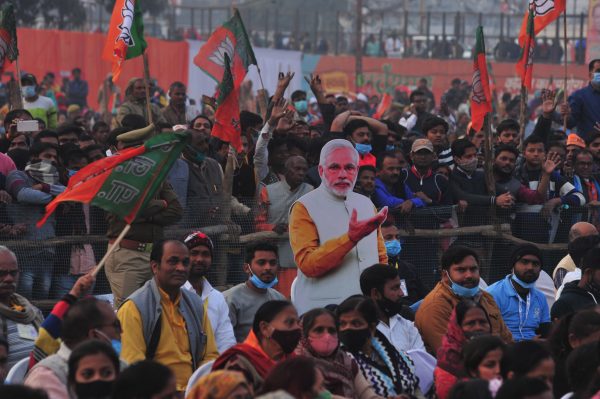At home, the ruling Bharatiya Janata Party (BJP) repealed three new farm laws in November after it failed to win over thousands of farmers who waged a successful high-profile protest for more than a year. Passed hurriedly without sufficient parliamentary scrutiny, these laws that were directed toward privatising the agricultural sector threatened the existing rights of farmers and they lost trust in the government. The retraction by the government represented a visible victory for democracy even as India’s democratic credentials came into serious questioning.
Earlier in the year, Freedom House changed India’s status from ‘free’ to ‘partly-free’, for the first time since 1997, pointing to ‘rising violence and discriminatory policies affecting the Muslim population’ as well as a ‘crackdown on expressions of dissent’. As the year ended, the government stepped up its squeeze of non-governmental organisations and revoked licenses to receive foreign funds for two widely admired organisations, Oxfam and Mother Teresa’s Missionaries of Charity. Whatever one thinks of Freedom House and western hypocrisy, it was not a good look for the world’s biggest democracy.
Meanwhile, as the largest global vaccine manufacturer, the country was all set to reap soft power benefits from its initial vaccine diplomacy which would have contributed to rescuing a pandemic-stricken world. By April, India had already delivered over 66 million doses of mostly free vaccines to developing countries. But India’s image was dealt a deadly blow after the government’s ignominious response to the second wave of COVID-19, the crisis in vaccine production by the Serum Institute of India and the resultant emergency ban on vaccine exports. It has taken six months for the exports to slowly restart.
India got no relief outside its borders in 2021 either. The country was handed a diplomatic nightmare with the unceremonious withdrawal by the United States from Afghanistan in August. The return of the Taliban to power with little accountability represented a strategic windfall for Pakistan and a huge liability for India which had been closely aligned to the previous dispensation in Kabul under Ashraf Ghani. Initially, New Delhi did not show much imagination in dealing with this new unenviable scenario which could well embolden its adversary Pakistan.
The Modi government finally took a bold and innovative move in November by hosting a regional security dialogue on Afghanistan at the national security advisor level. While China and Pakistan declined India’s invitation to the meeting, seven other countries including Russia and Iran, along with five Central Asian countries attended. The eight attendees signed the Delhi Declaration which stated that: ‘Afghanistan’s territory should not be used for sheltering, training and planning or financing any terrorist acts’. Surprisingly, Taliban spokesperson Suhail Shaheen struck a rather conciliatory tone and said that they viewed the India-led meeting as a positive step.
Strategically, the fall of the Ghani government could not have come at a worse time for New Delhi. The country’s security situation had already worsened after the border clash with China in Galwan in 2020. China and India have been unable to break the impasse in their relations even after 13 rounds of talks between senior border commanders. There was no marked improvement in 2021, with the latest round in October ending in an acrimonious exchange between the two sides.
Tense relations with Pakistan on the western front and with China on the eastern front have brought New Delhi closer to realising its growing fear of a potential two-front conflict which poses a formidable challenge for India with no easy answers. The Quadrilateral Security Dialogue did pick up momentum in 2021 with the first ever in-person leaders’ summit in September held at the White House. If nothing else, its continuing buoyancy buys India some insurance in terms of security, especially in the Indo-Pacific.
India, like most other countries, has been struggling toward a post-pandemic recovery. The Omicron outbreak found India better prepared than the second Delta wave with almost 60 per cent of adults fully vaccinated. The urban job crisis has persisted, with the government’s highly touted target of expanding manufacturing again not met, an outcome made worse by the huge loss of lives and livelihoods caused by the pandemic.
India is also missing out the opportunity of redirecting manufacturing from China as many expected. Instead, those investments and jobs out of China have gone to Vietnam and other Southeast Asian states. Still, the International Monetary Fund projects that India will prove to be the fastest growing major economy in 2021 at 9.5 per cent despite reducing its projections after the set back of the second COVID-19 wave.
If this holds into 2022, India might just find itself in a position to reverse the reversal of 2021.
Deepa Ollapally is Research Professor of International Affairs and Director of Rising Powers Initiative, Elliott School of International Affairs, The George Washington University.
This article is part of an EAF special feature series on 2021 in review and the year ahead.


Your article is good but representing facts as half glass empty. In reality you should admire the efforts taken by Indian govt during Covid epidemic, considering population and ground realities compared to other countries. I move around India for 3-4 months and I see lot of development and awareness. George Washington University stands for truth and facts. Please don’t twist facts to entertain certain section of your readers. I invite to visit India and see facts yourself.